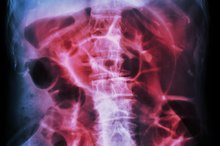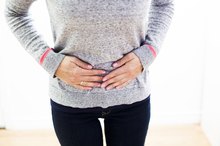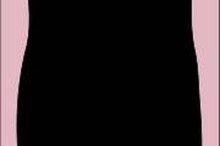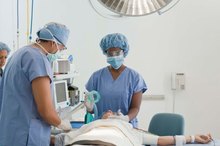Belly Button Pain After Eating Food
Belly button or umbilicus pain may be caused by a variety of factors, including abdominal hernias, umbilical infections, gastroenteritis, appendicitis or other gastrointestinal disorders. But if the pain primarily occurs after eating, indigestion is a common culprit. Since many digestive system disorders have overlapping symptoms, it can be hard to pin down the precise cause of this pain. So if you have any severe or ongoing gastrointestinal discomfort, see your doctor.
If you are experiencing serious medical symptoms, seek emergency treatment immediately.
Indigestion
Indigestion, also referred to as functional dyspepsia, is a common cause of pain in the upper abdomen and belly button area 2. This discomfort, which is common after eating, is typically accompanied by fullness, early satiety, and a burning sensation. Dyspepsia can overlap with symptoms of reflux disease and irritable bowel syndrome, so a medical evaluation is important for an accurate diagnosis. Treatment includes diet modifications, specifically eating small, lower fat meals and avoiding any foods that worsen symptoms, along with medications that block or neutralize acid production.
Gas and Bloating
Distended Colon Symptoms
Learn More
Gas is a normal part of digestion, and often linked to eating certain foods, including beans, lentils, broccoli, cabbage, and many other fruits and vegetables 6. Excess gas is also produced when foods are not properly digested, as occurs with intolerance to the lactose, the natural sugar in milk. When gas builds up after meals, pain, discomfort and bloating can follow. This gas can also make the abdomen more firm or hard, which can aggravate pain from another condition -- such as an infection in the naval area, surgical incision pain, or a painful inguinal hernia, a condition in which soft tissue in the belly button area bulges out of weak abdominal muscle.
- Excess gas is also produced when foods are not properly digested, as occurs with intolerance to the lactose, the natural sugar in milk.
- This gas can also make the abdomen more firm or hard, which can aggravate pain from another condition -- such as an infection in the naval area, surgical incision pain, or a painful inguinal hernia, a condition in which soft tissue in the belly button area bulges out of weak abdominal muscle.
Other Gastrointestinal Causes
Pain felt near the naval may also be a sign of a stomach ulcer, although this ulcer pain can occur before or after eating. Most stomach ulcers are the result of erosion of the stomach lining from an infection or irritant. Gallstones, which are collections of solid material in the gallbladder, may lead to pain in the navel area. This pain can occur at any time but may worsen after eating fatty meals. Constipation may also lead to pain around the belly button, although this pain may not be specific to meal timing 1.
Warnings
What Are the Side Effects of Gallbladder Removal?
Learn More
If you have belly button pain that is ongoing or severe, see your doctor. Although this pain could be related to a manageable condition such as indigestion, it could also be a sign of Crohn disease, an inflammatory bowel disease, or another serious disorder 4. Belly button pain could also signal a medical emergency, such as appendicitis, pancreatitis or a hernia complication. If you experience severe pain, vomiting, bloody stools, or pain due to abdominal injury, see your doctor right away.
Reviewed by Kay Peck, MPH RD
- If you have belly button pain that is ongoing or severe, see your doctor.
- Although this pain could be related to a manageable condition such as indigestion, it could also be a sign of Crohn disease, an inflammatory bowel disease, or another serious disorder 4.
Related Articles
References
- American College of Gastroenterology: Functional Abdominal Pain in Children
- American College of Gastroenterology: Management of Dyspepsia
- Merck Manual: Crohn Disease
- American Family Physician: Peptic Ulcer Disease
- Merck Manual: Gas-Related Complaints
- Talley NJ, Phung N, Kalantar JS. ABC of the upper gastrointestingal tract: Indigestion: When is it functional?. BMJ. 2001;323(7324):1294-7. doi:10.1136/bmj.323.7324.1294
- Vakil, N., et. al. "Symptom Overlap Between Postprandial Distress and Epigastric Pain Syndromes of the Rome III Dyspepsia Classification" American Journal of Gastroenterology 2013 108:767–774.
- Talley, N., Phung, N. & Kalantar, J. "Indigestion: When is it functional?" BMJ 2001 323:1294–1297.
Writer Bio
Diane Marks started her writing career in 2010 and has been in health care administration for more than 30 years. She holds a registered nurse license from Citizens General Hospital School of Nursing, a Bachelor of Arts in health care education from California University of Pennsylvania and a Master of Science in health administration from the University of Pittsburgh.







